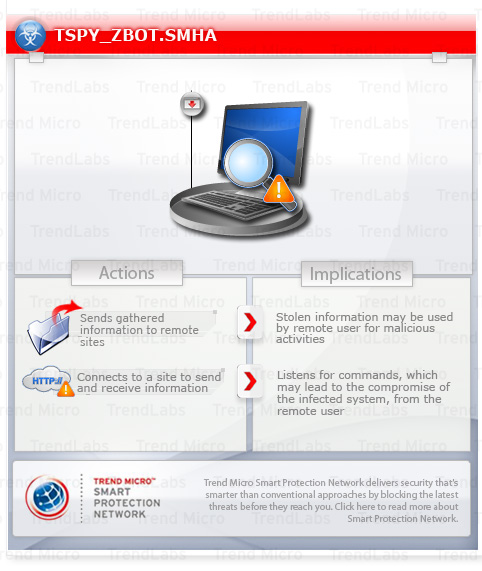TSPY_ZBOT.SMHA
Windows 2000, Windows XP, Windows Server 2003


Threat Type: Trojan
Destructiveness: No
Encrypted: Yes
In the wild: Yes
OVERVIEW
This spyware has increased potential for damage, propagation, or both, that it possesses. Specifically, attempts to steal user information such as user names, passwords, and banking credentials.
To get a one-glance comprehensive view of the behavior of this Trojan, refer to the Threat Diagram shown below.

This Trojan may be dropped by other malware. It may be unknowingly downloaded by a user while visiting malicious websites.
It may be injected into processes running in memory.
It opens a random port to allow a remote user to connect to the affected system. Once a successful connection is established, the remote user executes commands on the affected system.
It attempts to steal sensitive online banking information, such as user names and passwords. This routine risks the exposure of the user's account information, which may then lead to the unauthorized use of the stolen data. It retrieves specific information from the affected system.
TECHNICAL DETAILS
Random
Varies
PE
Yes
16 Feb 2011
Drops files, Compromises system security, Modifies system registry
Arrival Details
This Trojan may be dropped by other malware.
It may be unknowingly downloaded by a user while visiting malicious websites.
Installation
This Trojan drops the following files:
- %Application Data%\{random folder name 1}\{random file name}.exe - copy of itself
- %Application Data%\{random folder name 2}\{random file name} - contains encrypted stolen data
(Note: %Application Data% is the current user's Application Data folder, which is usually C:\Documents and Settings\{user name}\Application Data on Windows 2000, XP, and Server 2003, or C:\Users\{user name}\AppData\Roaming on Windows Vista and 7.)
It creates the following folders:
- %Application Data%\{random folder name 1}
- %Application Data%\{random folder name 2}
(Note: %Application Data% is the current user's Application Data folder, which is usually C:\Documents and Settings\{user name}\Application Data on Windows 2000, XP, and Server 2003, or C:\Users\{user name}\AppData\Roaming on Windows Vista and 7.)
It is injected into the following processes running in memory:
- explorer.exe
- taskhost.exe
- taskeng.exe
- Dwm.exe
- wscntfy.exe
- ctfmon.exe
- rdpclip.exe
It may be injected into processes running in memory.
Autostart Technique
This Trojan adds the following registry entries to enable its automatic execution at every system startup:
HKEY_CURRENT_USER\Software\Microsoft\
Windows\CurrentVersion\Run
{GUID} = %Application Data%\{random folder name 1}\{random file name}.exe
Other System Modifications
This Trojan adds the following registry keys as part of its installation routine:
HKEY_CURRENT_USER\Software\Microsoft\
{random characters}
It creates the following registry entry(ies) to bypass Windows Firewall:
HKEY_LOCAL_MACHINE\SYSTEM\CurrentControlSet\
Services\SharedAccess\Parameters\
FirewallPolicy\StandardProfile\AuthorizedApplications\
List
%Windows%\EXPLORER.EXE = %Windows%\EXPLORER.EXE:*:Enabled:Windows Explorer
Backdoor Routine
This Trojan opens a random port to allow a remote user to connect to the affected system. Once a successful connection is established, the remote user executes commands on the affected system.
Information Theft
This Trojan attempts to steal sensitive online banking information, such as user names and passwords. This routine risks the exposure of the user's account information, which may then lead to the unauthorized use of the stolen data.
It accesses the following site to download its configuration file:
- http://www.{BLOCKED}ptbiz.ru/turkishxan.bin
- http://{BLOCKED}orntonllp.com/IEupdater.bin
It retrieves the following information from the affected system:
- Personal certificates (MY)
- FTP credentials
- Internet session cookies
- Flash player data
NOTES:
As of this writing, the said sites are inaccessible.
It monitors the Internet Explorer (IE) activities of the affected system, specifically the address bar or title bar. It recreates a legitimate website with a spoofed login page if a user visits banking sites with certain strings in the address bar or title bar.
SOLUTION
8.900
7.843.00
18 Feb 2011
Step 1
Before doing any scans, Windows XP, Windows Vista, and Windows 7 users must disable System Restore to allow full scanning of their computers.
Step 2
Restart in Safe Mode
Step 3
Delete this registry key
Important: Editing the Windows Registry incorrectly can lead to irreversible system malfunction. Please do this step only if you know how or you can ask assistance from your system administrator. Else, check this Microsoft article first before modifying your computer's registry. Before you could do this, you must restart in Safe Mode. For instructions on how to do this, you may refer to this page If the preceding step requires you to restart in safe mode, you may proceed to edit the system registry.
- In HKEY_CURRENT_USER\Software\Microsoft
- {random characters}
Step 4
Delete this registry value
Important: Editing the Windows Registry incorrectly can lead to irreversible system malfunction. Please do this step only if you know how or you can ask assistance from your system administrator. Else, check this Microsoft article first before modifying your computer's registry.
- In HKEY_CURRENT_USER\Software\Microsoft\Windows\CurrentVersion\Run
- {GUID} = %Application Data%\{random folder name 1}\{random file name}.exe
- In HKEY_LOCAL_MACHINE\SYSTEM\CurrentControlSet\Services\SharedAccess\Parameters\FirewallPolicy\StandardProfile\AuthorizedApplications\List
- %Windows%\EXPLORER.EXE = %Windows%\EXPLORER.EXE:*:Enabled:Windows Explorer
Step 5
Search and delete this folder
- %Application Data%\{random folder name 1}
- %Application Data%\{random folder name 2}
Step 6
Restart in normal mode and scan your computer with your Trend Micro product for files detected as TSPY_ZBOT.SMHA. If the detected files have already been cleaned, deleted, or quarantined by your Trend Micro product, no further step is required. You may opt to simply delete the quarantined files. Please check this Knowledge Base page for more information.
Did this description help? Tell us how we did.

